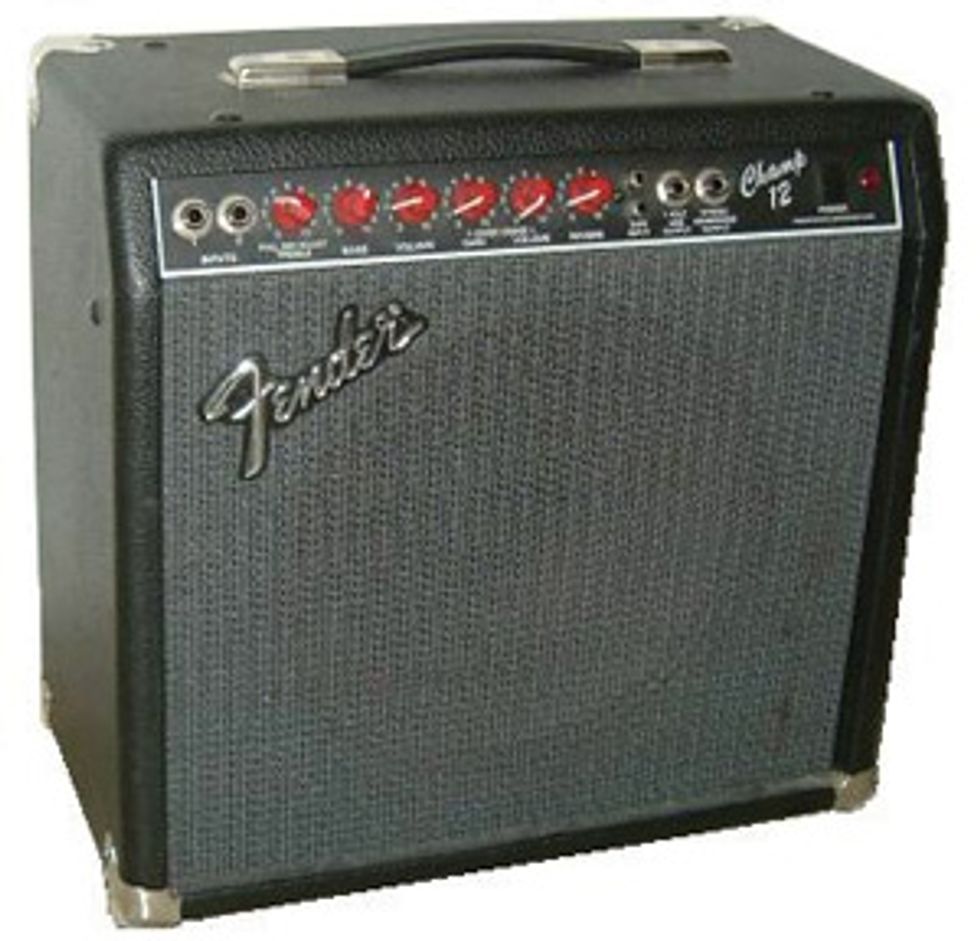
Produced between 1987 and 1992, the Fender Champ 12 is a 12-watt, 1x12 combo with a single 6L6 power tube and a pair of 7025 preamp tubes. Photo courtesy of telecaster.com
Hi Jeff,
I have a Fender Champ 12 from the late ’80s that I’m curious about. The input jack is
broken, and it has never been re-tubed or probably even serviced since it was new. I’ve
given up on trying to get any useful, adjustable gain out of it, and the reverb is pretty
much just full on or off. I primarily use it as a practice amp at home, typically at lower
volumes, and I’d love to get tones similar to a Fender Tonemaster. Is that possible?
Thanks,
Leonard
Hi Leonard,
When a customer brought his Champ 12 in
for service years ago, a couple of this amp’s
unique “innovations” had me scratching
my head. There are aspects of the electronic
design I’ve not seen in any other Fender amp.
The Champ 12 I repaired had multiple problems: Its output was low and distorted, and it wouldn’t switch channels. Before pulling a schematic on the unit, I took a few minutes to troubleshoot it. Sure enough, the output looked very bad on the oscilloscope, and there was no low voltage for the switching circuitry. When I started tracing the wiring associated with the switching circuitry, it unexpectedly led me to the output stage! I figured this can’t be right—someone must have already gotten their inexperienced, grubby little paws into the amp and moved some wires.
It was then I realized what was actually going on. The amp had been designed to tap voltage off of the cathode circuit in the cathode-biased output stage as a low-voltage source for the switching circuitry. Wow, I hadn’t seen that before. I checked the resistors in the cathode circuit, and then replaced one that was way out of tolerance. That was it—the switching circuitry now had voltage and the output of the amp was great. Okay, I won’t forget that the next time a Champ 12 comes in with the same set of problems. But let’s move on to your amp and see if we can address some of your concerns.
The first thing I’d suggest is to re-tube the amp, especially if that has never been done before. You may hear a noticeable improvement. Also, be sure to have the cathode resistors in the output stage checked, as we already know what kinds of problems they can cause. I’d also recommend having the broken input jack replaced. It’s generally the number 1 input jack that breaks and typically that’s the most useable input for guitar.
Being a 10–12 watt amp, the Champ 12 is, of course, never going to sound as big and bold as the 100-watt Tonemaster, nor will it have that kind of distortion unless the entire circuit is completely rebuilt. So what I’m shooting for is to bring the amp’s tone closer to the Tonemaster.
We’ll start with the tone stacks, as they’re noticeably different in these two amps. Locate the three main capacitors in the Champ’s tone circuit—C3, C4, and C5. Replace the 250 pF ceramic cap (C3) with a 150 pF with at least a 250V rating. Next, replace the 0.1 μF (C4) with a .047 μF 400-600V. Feel free to use the original C5 cap here, as C5 will be replaced by a 0.022 μF 400-600V cap. This should set up the tonal characteristics to be closer to the Tonemaster.
You mentioned the amp didn’t have much gain adjustability. This may be due to the type of “shunt-to-ground” volume controls (something I generally don’t care for) used in the Champ 12, but if you’ve found the gain is a bit too loose and broken up, I’d suggest changing the value of C1. Using a 25 μF capacitor on the first gain stage can sometimes provide too much amplification of the lower frequencies, which can muddy up the overdrive. I’d suggest switching the locations of C1 (25 μF) and C8 (0.68 μF). Install the 0.68 μF capacitor in the cathode stage of V1A and the 25 μF capacitor in the cathode stage of V1B.
Another option would be to switch the locations of C1 and C12, instead of C8. This would place the 25 μF cap one stage further down the line.
You mentioned that the reverb is delivering all or nothing, but this may be due to an incorrect adjustment. The reverb in these amps is the other unique “innovation” I mentioned earlier. It’s actually driven by the signal going to the speaker!
I had seen this done before in early amps from a different manufacturer, but not in a Fender. It seems this unique design requires the proper adjustment of an internal pot to work properly. I won’t go into the procedure for this because you can find it on Fender’s supplied schematic for this amp. If you have this adjusted properly, it may make your reverb a bit more useable, although I wouldn’t expect full reverb bliss from this frugal design.
Last and definitely not the least, I’d encourage you to change the speaker. The Tonemaster came stock with either a Celestion Vintage 30 or Celestion G12- 80, both of which would sound substantially different from the stock Fender blue-label speaker currently in your amp. I hope these suggestions make your amp a real Tone Champ!
 Jeff Bober is one of
the godfathers of the
low-wattage amp revolution,
co-founded and was
the principal designer for
Budda Amplification. Jeff recently launched EAST
Amplification, and he can be reached at
pgampman@gmail.com.
Jeff Bober is one of
the godfathers of the
low-wattage amp revolution,
co-founded and was
the principal designer for
Budda Amplification. Jeff recently launched EAST
Amplification, and he can be reached at
pgampman@gmail.com.













![Rig Rundown: Russian Circles’ Mike Sullivan [2025]](https://www.premierguitar.com/media-library/youtube.jpg?id=62303631&width=1245&height=700&quality=70&coordinates=0%2C0%2C0%2C0)









